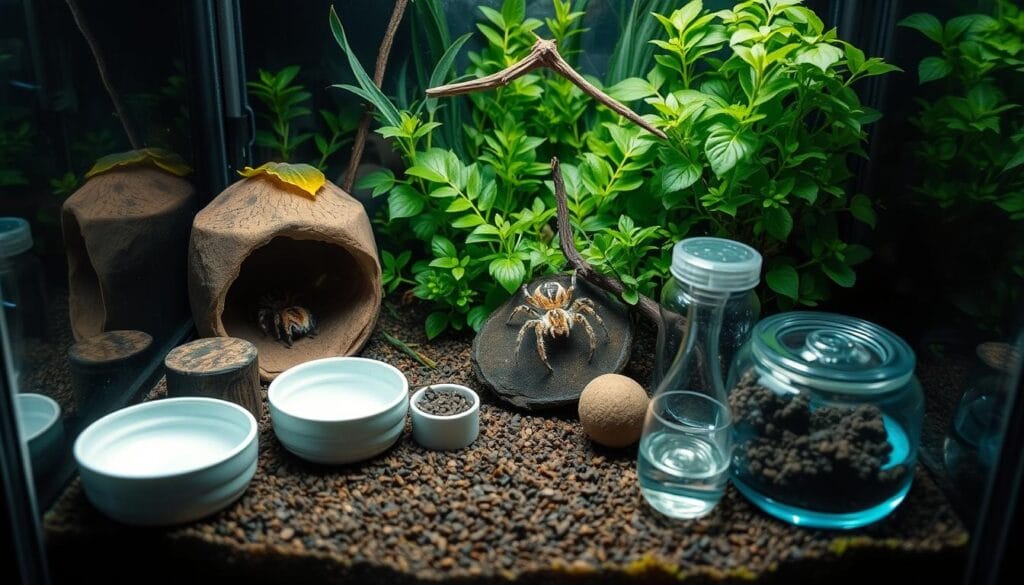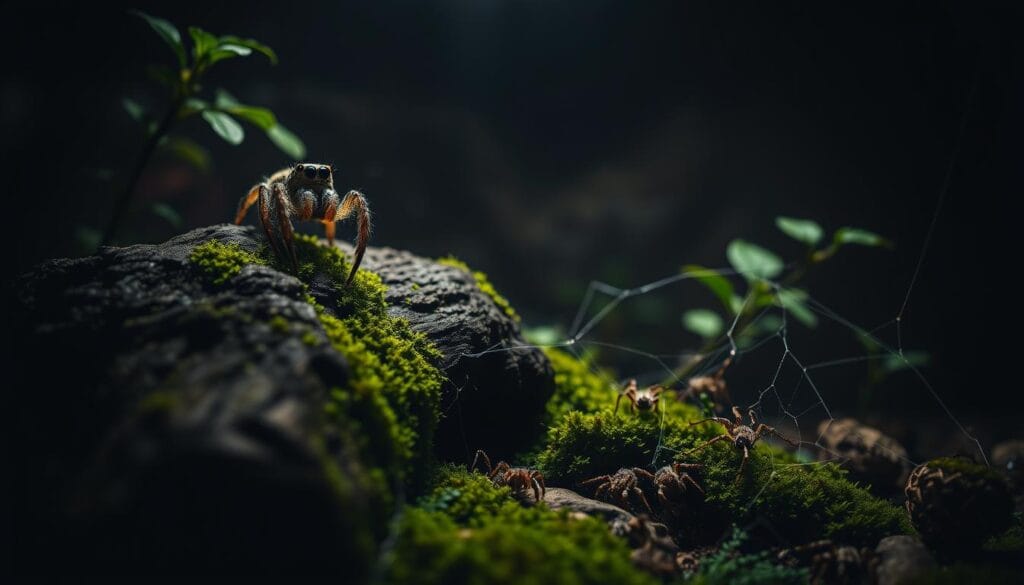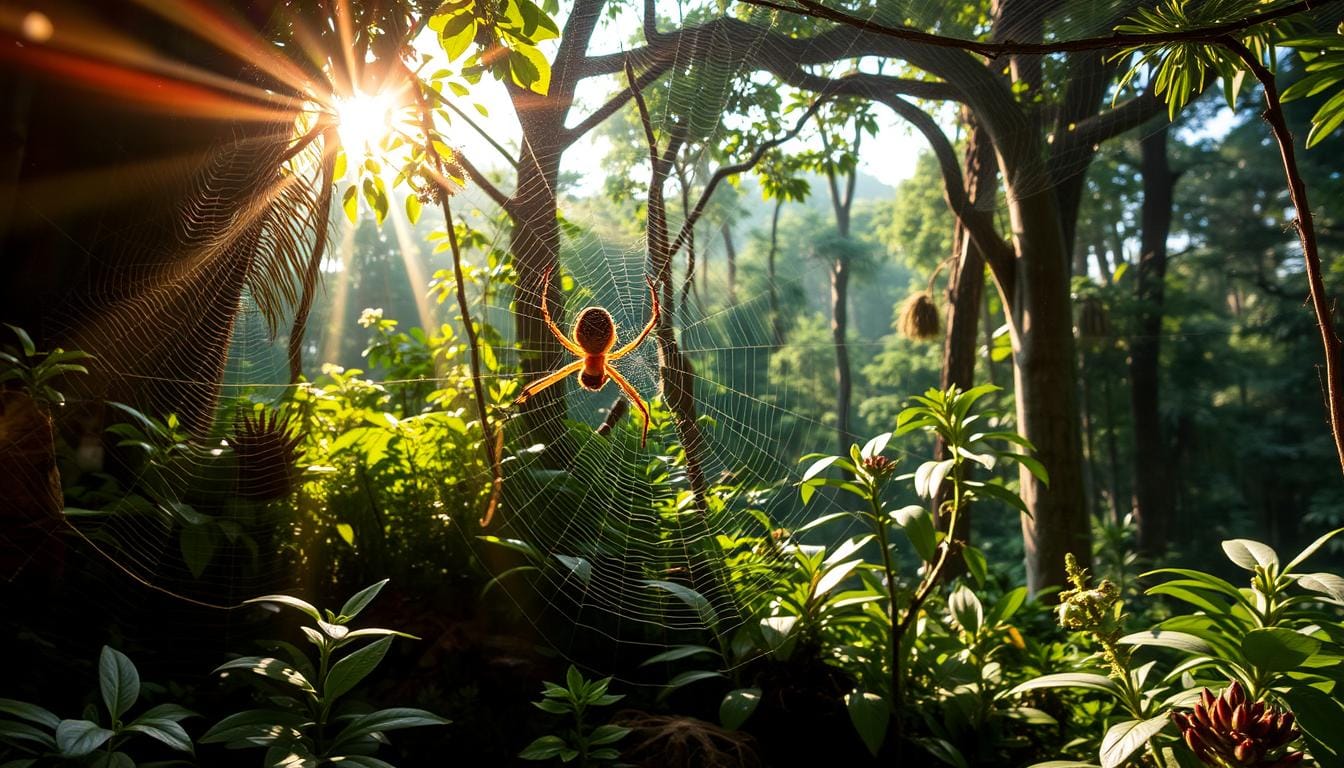If you own a pet spider, you want the best for them. A great spider habitat is key for their health and happiness.
A Jumping Spider Terrarium Kit is a smart pick. It offers everything you need for a perfect home. But, with so many choices, picking the right one can be tough. This article will guide you through the best Jumping Spider Terrarium Kits, based on reviews.
Table of Contents
What is a Jumping Spider Terrarium Kit?
For those who love spiders, a Jumping Spider Terrarium Kit is a great choice. It lets you build a home for these amazing creatures. The kit has everything you need to make a DIY spider enclosure that feels like their natural habitat.
Jumping spiders live in many places, like grasslands and forests. Knowing where they live helps you set up a good arachnid terrarium setup. Their homes have lots of plants and places to hide.
Overview of Jumping Spider Habitats
Jumping spiders need places to hide and find food. Their homes have plants, rocks, and other spots to hide. When you set up a terrarium, make sure it has these things too.
Replicating the natural environment is more than just adding plants. You need to think about how to make a space that lets the spider hunt and build webs.
Importance of Proper Setup
Setting up the terrarium right is key for your spider’s health. You need the right soil, the right temperature and humidity, and good air flow. A good terrarium helps your spider stay healthy and happy.
By knowing what jumping spiders need and using a Jumping Spider Terrarium Kit, you can make a great home for them. Taking care of the terrarium is important to enjoy watching these interesting spiders.
Key Features to Look for in a Kit
To create a thriving environment for your jumping spider, it’s essential to understand the key features of a terrarium kit. A well-designed spider tank kit or spider care kit provides the necessary conditions for your spider’s health and happiness.
Size and Dimensions of the Terrarium
The size of the terrarium is crucial because it determines the environment’s overall quality. A larger terrarium can provide a more stable environment, but it also requires more maintenance. Consider a terrarium that is at least 12 inches tall and has a diameter of 8-12 inches to give your spider enough space to jump and thrive.
Materials Used in Construction
The materials used in the construction of the terrarium are vital for durability and visibility. Look for terrariums made from high-quality, non-toxic materials that are easy to clean. Glass terrariums are preferred over plastic ones because they provide better visibility and are less prone to scratches.
| Material | Durability | Visibility |
|---|---|---|
| Glass | High | Excellent |
| Plastic | Medium | Good |
Accessibility for Cleaning and Maintenance
Easy access to the terrarium is essential for regular cleaning and maintenance. Look for kits that have a removable top or a wide opening that allows you to easily reach inside. This feature is important for feeding your spider and replacing substrate or decorations.
By considering these key features, you can select a spider care kit that meets your jumping spider’s needs, ensuring a happy and healthy pet.
Top Recommended Jumping Spider Terrarium Kits
The market has many jumping spider terrarium kits, but some are better than others. It’s important to look at several factors when choosing a kit. This ensures you give your pet spider the best home.
Kit1: Detailed Review and Features
The Bantam Earth Jumping Spider Enclosure Kit is a top pick. It comes with a full spider housing set to help your spider thrive. It has a big terrarium, good ventilation, and easy cleaning access.
Kit2: Customer Reviews and Feedback
Reviews for the PreVue Pet Products Jumping Spider Terrarium show it’s durable and looks good. People like its pet spider enclosure design. It’s safe and fun for their jumping spiders.
Kit3: Value for Money Comparison
The Zoo Med Jumping Spider Terrarium Kit is great value. It has everything you need at a good price. It’s perfect for both new and experienced spider keepers.
In summary, the right jumping spider terrarium kit depends on your needs and wants. Look at features, reviews, and price to choose well. This way, you’ll give your pet spider a happy and healthy home.
Essential Accessories for Your Terrarium
To make your jumping spider’s home better, add some key accessories to your terrarium. These items can make the space more natural and fun for your spider.
Substrates and Bedding Options
The right bedding is key for keeping your terrarium humid and comfy for your spider. Here are some good choices:
- Peat Moss: It holds moisture well, keeping the air humid.
- Coconut Fiber: This eco-friendly option also keeps moisture in, helping with humidity.
- Sand: Though it doesn’t hold moisture as well, sand works in well-ventilated terrariums.
For more tips on setting up your spider’s home, check out this setup guide.
Plants and Decorations to Consider
Adding plants and decorations makes your terrarium look better. They also give your spider places to hide and climb. Here are some ideas:
- Live Plants: Air plants or small ferns add a natural feel and can thrive in terrariums.
- Rocks and Branches: They create paths for your spider to climb and places to hide.
- Decorative Moss: Moss covers surfaces, making the terrarium feel like a forest.

Heating and Lighting Solutions
Jumping spiders need the right temperature and light. Here’s what you can use:
| Accessory | Description | Benefits |
|---|---|---|
| Heat Mats | These mats provide gentle heat from below. | Keep the temperature just right for your spider. |
| Low-Wattage Bulbs | These bulbs light up the terrarium without getting too hot. | Give your spider the light it needs without overheating. |
| Thermometers | These tools help you keep an eye on the terrarium’s temperature. | Make sure the temperature stays safe for your spider. |
Adding these accessories to your Jumping Spider Terrarium Kit makes a great home for your pet.
Maintenance Tips for Your Terrarium
Keeping your jumping spider’s terrarium clean is key to its health. A clean environment makes the spider happy and fun to watch. It also helps the spider behave naturally.
Cleaning Practices
It’s important to clean the terrarium regularly. Use a soft-bristled brush or cotton swab to remove uneaten prey, molted skins, and feces. Clean the water and food dishes every day.
For a deeper clean, change the substrate every 4-6 weeks. Before you clean, have a safe place to put your spider.
Monitoring Environmental Conditions
Jumping spiders need the right humidity and temperature. Keep the humidity at 50-60% and the temperature between 75-85°F (24-29°C) during the day. At night, it should be a bit cooler.
| Environmental Factor | Recommended Range |
|---|---|
| Humidity | 50-60% |
| Temperature (Day) | 75-85°F (24-29°C) |
| Temperature (Night) | 70-75°F (21-24°C) |
Feeding Your Jumping Spider
Feeding your spider right is important for its health. Jumping spiders are smart and curious and need a diet of live insects. Feed them 1-2 times a week, based on their age and size.
“The key to a healthy jumping spider is a varied diet and a clean, well-maintained terrarium.”
Make sure the prey is the right size for your spider. A good size is 1/4 to 1/2 the spider’s body.
Common Mistakes When Setting Up a Kit
Creating a great home for your jumping spider needs careful planning. A well-designed arachnid terrarium setup is key for your spider’s health and happiness. But, many owners make mistakes that can be avoided with the right knowledge.
Overcrowding the Terrarium
One big mistake is overcrowding the terrarium. Jumping spiders need room to move and hunt. Overcrowding can cause stress and even cannibalism. Make sure your spider tank kit is big enough for your spider to roam freely.
- Provide enough space for your spider to web and hunt.
- Avoid housing multiple jumping spiders together unless they are paired for breeding.
- Consider a terrarium that is at least 5-10 gallons for a single adult jumping spider.
Ignoring Environmental Needs
Jumping spiders have specific needs for a healthy life. Ignoring these can stress or harm your spider. For more detailed guidance, check out this step-by-step guide on setting up an invertebrate terrarium.
“The right environment is key to the well-being of your jumping spider. Ensure you provide the correct humidity, temperature, and lighting conditions.”
To get it right:
- Research the specific humidity and temperature requirements for your spider species.
- Use a hygrometer and thermometer to monitor the conditions in your terrarium.
- Adjust heating and lighting elements as necessary to maintain optimal conditions.
Inadequate Feeding Practices
Feeding your jumping spider correctly is vital for its health. Inadequate feeding can lead to malnutrition or stress. It’s crucial to understand your spider’s feeding needs.

- Provide live prey that is appropriately sized for your spider.
- Feed your spider according to its age and species-specific needs.
- Ensure a varied diet to provide a broad spectrum of nutrients.
By avoiding these common mistakes, you can create a thriving environment for your jumping spider. This ensures it lives a healthy and happy life in its spider tank kit.
Creating a Natural Habitat for Jumping Spiders
To keep your jumping spider healthy and happy, it’s key to create a natural environment in the terrarium. A well-designed spider housing set can make your pet feel at home. It provides a familiar and comfortable space.
Jumping spiders live in various places like grasslands, forests, and cities. To make a great home for them, you need to know and copy their natural settings.
Mimicking Their Natural Environment
To mimic their natural home, you must replicate the conditions they face in the wild. This includes the substrate, temperature, humidity, and lighting. For a spider care kit, picking the right parts is vital for adjusting these factors.
For example, a moist substrate helps keep the terrarium’s humidity right. Adding rocks, logs, and plants gives your spider places to hide and climb. This makes the terrarium more natural and fun.
Using Live Plants for Aesthetic and Functionality
Live plants are not just pretty; they’re also key to your terrarium’s health. They help control humidity and offer places for your spider to hide and hunt.
When picking plants, choose ones that fit your spider’s needs. Moss and ferns do well in humid places and make the terrarium look lush and natural.
By adding live plants and designing the terrarium like their natural home, you create a spider housing set that’s both good for your spider and looks great.
Understanding Jumping Spider Behavior
To keep jumping spiders happy, it’s important to understand their behavior. By knowing their needs, you can make a pet spider enclosure that feels like home. This way, they can live their best lives.
Social vs. Solitary Species
Most jumping spiders like to be alone. But some can get along with others better. It’s key to know if your spider likes company or prefers to be by itself.
For example, Phidippus audax spiders can get quite aggressive. They should live alone. But some spiders are more laid-back. Knowing this helps keep your spider friends happy and healthy.
How Environment Influences Activity Levels
The setup of a tarantula starter kit or a jumping spider terrarium affects how active they are. Things like light, temperature, and humidity play big roles. They can make your spider more active or less.
For example, the right temperature can make them hunt like they do in the wild. But the wrong humidity can stress them out. By tweaking these things, you can help your spider stay active and stress-free.
To make your spider’s home even better, add things that remind them of the wild. Plants, rocks, and different textures can be great. They give your spider something to do and see, like building webs and hunting.
Where to Buy the Best Jumping Spider Terrarium Kits
Now that you know how to create a great home for your jumping spider, it’s time to find the right terrarium kit. You can look for kits online or in local pet stores. Each place has its own advantages and disadvantages.
Online Retailers and Reviews
Online stores like Petco and Chewy have many Jumping Spider Terrarium Kits. Reading what other customers say can help you choose. Look for kits with lots of positive reviews and clear descriptions to find a good spider habitat.
Local Pet Stores and Recommendations
Going to local pet stores lets you see kits in person and get advice from experts. They can tell you which kits are best for your spider’s needs.
Think about shipping time, customer service, and the kit’s price when deciding where to buy. By researching and comparing, you can find the perfect Jumping Spider Terrarium Kit. This will make your spider’s home happy and healthy.


1 thought on “Jumping Spider Terrarium Kit: Best Reviews”